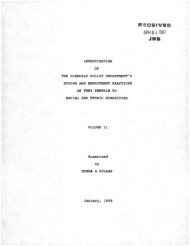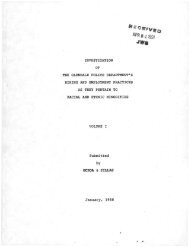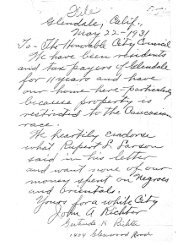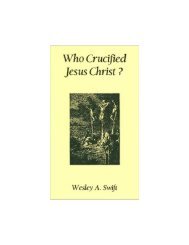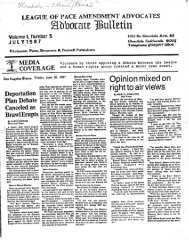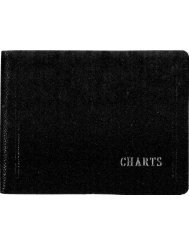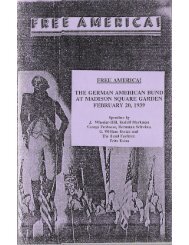Create successful ePaper yourself
Turn your PDF publications into a flip-book with our unique Google optimized e-Paper software.
CITY OF GLENDALE, CALIFORNIA<br />
REPORT TO THE CITY COUNCIL<br />
AGENDA ITEM<br />
<strong>Report</strong>: Acknowledgement of the City of <strong>Glendale</strong>’s Historical Contributions to Racism<br />
1. Resolution Authorizing Staff to Prepare and Issue a Request for Proposals to<br />
Complete a Historical Context Statement for the City of <strong>Glendale</strong><br />
2. Resolution Acknowledging the Racially Exclusionary Past of <strong>Glendale</strong>, California as a<br />
“<strong>Sundown</strong> <strong>Town</strong>”<br />
COUNCIL ACTION<br />
Item Type: Action Item<br />
Approved for September 15, <strong>2020</strong> calendar<br />
ADMINISTRATIVE ACTION<br />
Submitted by:<br />
John Takhtalian, Deputy City Manager<br />
Prepared by:<br />
Nicole Pasini, Assistant Director of Library, Arts and Culture<br />
Bradley Calvert, Assistant Director of Community Development<br />
Christine B. Powers, Senior Executive Analyst<br />
Reviewed by:<br />
Michele Flynn, Director of Finance<br />
Gary Shaffer, Director of Library, Arts and Culture<br />
Philip S. Lanzafame, Director of Community Development<br />
Roubik R. Golanian, P.E., Assistant City Manager<br />
Michael J. Garcia, City Attorney<br />
Approved by:<br />
Yasmin K. Beers, City Manager<br />
{{section.number}}b
RECOMMENDATION<br />
Staff respectfully recommends that City Council direct staff to prepare and issue a<br />
request for proposals to complete a historical context statement for the City of <strong>Glendale</strong>.<br />
Staff also recommends that City Council adopt a resolution acknowledging the racially<br />
exclusionary past of <strong>Glendale</strong> as a “sundown town.”<br />
BACKGROUND/ANALYSIS<br />
On July 21, <strong>2020</strong> in response to the nationwide dialogue on race and equity, and as part<br />
of a long-term effort to foster diversity, equity, and inclusion, City Council approved the<br />
City’s membership in the local and regional Government Alliance on Race & Equity<br />
(GARE). GARE is a national network of governments working to achieve racial equity<br />
and advance opportunities for all. Joining GARE provides staff with access to the<br />
organization’s resources, network, and staff to develop and present an action plan for<br />
consideration and discussion by City Council. Concurrently, the Police Department is<br />
reviewing its use of policies based on recommendations that were made by Attorney<br />
General Xavier Becerra, and will bring a report back to Council at some point.<br />
Part of the request from Council on this topic included an acknowledgement of<br />
<strong>Glendale</strong>’s past with regard to race. As such, staff has been reviewing available historic<br />
documents to identify and understand <strong>Glendale</strong>’s history as it pertains to its racist past.<br />
The City of <strong>Glendale</strong> was incorporated as a charter city in 1906. In 1920, the U.S.<br />
Census reported that the African American population of <strong>Glendale</strong> was 0.16%, and that<br />
population was likely comprised of live-in domestic workers. In 2019, the U.S. Census<br />
reported that the African American population of <strong>Glendale</strong> was 1.6%. Comparatively,<br />
the African American population for Los Angeles County was 9.0% in 2019, according<br />
to the U.S. Census. This disparity in racial makeup warrants an exploration of the<br />
history of <strong>Glendale</strong>.<br />
James Loewen, sociologist, professor, and author of <strong>Sundown</strong> <strong>Town</strong>s: A Hidden<br />
Dimension of American Racism, defines sundown towns as “any organized jurisdiction<br />
that for decades kept African Americans or other groups from living in it and was thus<br />
‘all-white’ on purpose,” through formal and informal methods. Loewen identified over<br />
100 sundown towns in California in his research, including <strong>Glendale</strong>. 1<br />
Informal methods to exclude Black people and other people of color from <strong>Glendale</strong><br />
included intimidation and violence. Harassment of Black people who moved into<br />
<strong>Glendale</strong>, or who were visiting <strong>Glendale</strong>, is well documented with hate crimes reported<br />
1<br />
Loewen, James W. <strong>Sundown</strong> <strong>Town</strong>s: A Hidden Dimension of American Racism. New York: Simon & Schuster,<br />
2006.<br />
2 {{section.number}}b
in newspapers from the 1900s through the 1990s. 2 3 4 Contemporaneous accounts and<br />
oral histories from Black people who worked in or lived near <strong>Glendale</strong> consistently note<br />
hostility and discrimination. 5 6 7 8 910 Additionally, individuals who were not white were<br />
prohibited from being buried in <strong>Glendale</strong>’s Forest Lawn Memorial Park until the 1960s. 11<br />
Formal methods that kept <strong>Glendale</strong> all white are most clearly represented by racially<br />
restrictive covenants in housing. In the 1910s and 1920s, racially restricted housing was<br />
noted in advertisements for <strong>Glendale</strong> homes, 12 13 and by the 1940s, <strong>Glendale</strong> was<br />
noted as a model for other communities that wanted to racially restrict housing. 141516 In<br />
1940, <strong>Glendale</strong> was cited by the California Real Estate Association (CREA) “as being<br />
worthy of singular praise in its utilization of measures to keep it a ‘100% Caucasian<br />
Race Community’” due to the promotion of a pledge by homeowners which read, “I will<br />
not sell or rent to any person or groups other than the Caucasian Race.” In 1942, the<br />
<strong>Glendale</strong> CREA chapter formed Race Restriction Committee “to establish perpetual<br />
race restrictions on all parcels of property in <strong>Glendale</strong>.” 17 As late as 1949, <strong>Glendale</strong><br />
Realtors proudly declared their city a “100% Caucasian Race Community” in the<br />
CREA’s annual directory.” 18 Debate continued on the issue of “open housing” through<br />
the 1960s, 19 20 and controversy ensued when Black people did move into <strong>Glendale</strong>. 21<br />
2<br />
“Threat in <strong>Glendale</strong>: Negro Family is Ordered in Anonymous Communication to Leave <strong>Town</strong>.” Los Angeles Times<br />
(1886-1922); Apr 2, 1907; ProQuest Historical Newspapers: Los Angeles Times. P II10.<br />
3<br />
Alexander, Pat. “Postscript.” Los Angeles Sentinel (1934-2005); Dec 11, 1947; ProQuest Historical Newspapers:<br />
Los Angeles Sentinel. P 7<br />
4<br />
Man Admits Racist Action Against Black: [Home Edition]. Los Angeles Times (pre-1997 Fulltext); Mar 26, 1987;<br />
Global Newsstream. P 15.<br />
5<br />
“Negro Leader Assails Conditions in <strong>Glendale</strong>.” Los Angeles Times (1923-1995); Jul 16, 1963; ProQuest Historical<br />
Newspapers: Los Angeles Times. P 2.<br />
6<br />
Merritt, Bruce G. Faith and Fair Housing: An Episcopal Parish Church in the 1964 Debate over Proposition 14.<br />
Southern California Quarterly (2013) 95 (3): 284–316. https://doi.org/10.1525/scq.2013.95.3.284<br />
7<br />
Central Avenue Sounds: Lee Young. Interviewed by Stephen L. Isoardi, 1991. UCLA Library Center for Oral History<br />
Research, University of California, Los Angeles.<br />
8<br />
Central Avenue Sounds: Clora Bryant. Interviewed by Stephen L. Isoardi, 1990. UCLA Library Center for Oral<br />
History Research, University of California, Los Angeles.<br />
9<br />
Central Avenue Sounds: William Douglass. 1990. UCLA Library Center for Oral History Research, University of<br />
California, Los Angeles.<br />
10<br />
“Local relations group to reform” Richard Swearinger, R. 1986, Sept. 12, <strong>Glendale</strong> News Press.<br />
11<br />
“Integrating the City of the Dead: The Integration of Cemeteries and the Evolution of Property Law, 1900-1969.”<br />
Vol. 56:4. Alabama Law Review. P 1153. August 7, 2005.<br />
12<br />
ADVERTISEMENT. Los Angeles Herald, Volume XXXIX, Number 116, 13 February 1913. P 24.<br />
13<br />
Display Ad 220 -- No Title. Los Angeles Times (1886-1922); Apr 3, 1921; ProQuest Historical Newspapers: Los<br />
Angeles Times. P V4<br />
14<br />
“Ask Sign-up on Restrictions of Property Use.” La Habra Star, Volume XXIX, Number 51, 27 July 1945. P 1.<br />
15<br />
"Start Plan to Make Race Restrictions," La Habra Star, April 20, 1945, 1.<br />
16<br />
"Would Limit Residents to Caucasian Race," La Habra Star, December 22, 1944, 1<br />
17<br />
Goodman, George. “Bigotry of Fair Housing Act Opponents Rooted in Past.” Los Angeles Sentinel (1934-2005);<br />
Aug 27, 1964; ProQuest Historical Newspapers: Los Angeles Sentinel. pg. A12.<br />
18<br />
Hosang, D. (2010). Racial Propositions: Ballot Initiatives and the Making of Postwar California. University of<br />
California Press.<br />
3 {{section.number}}b
Although no official record of a <strong>Glendale</strong> sundown law has been found to date, there is<br />
ample documentary evidence that <strong>Glendale</strong> was a “sundown town.” For example, in<br />
1938, Los Angeles City Park Commissioners refused to allow the Civilian Conservation<br />
Corps to house a company of African American workers at Griffith Park because the<br />
bordering cities of <strong>Glendale</strong> and Burbank had ordinances which prohibited Black people<br />
from remaining after sun down. 22<br />
Additionally, <strong>Glendale</strong> has a history as home to white supremacist organizations that<br />
alone would have made the city hostile to African Americans. It is well documented that<br />
the Ku Klux Klan (KKK) was active in <strong>Glendale</strong> as early as the 1920s 23 24 when it was<br />
noted to be a “strong” organization including many of the business' men of the<br />
suburban city [as] members of the masked brotherhood.” 25 The KKK was active in<br />
<strong>Glendale</strong> into the 1960s. 26 Other white supremacist organizations established<br />
themselves in <strong>Glendale</strong>, including the American Nazi Party in the 1960s and 1970s 2728 ,<br />
the League of Pace Amendment Advocates in the 1980s 29 , and various Aryan<br />
nationalist groups in the 1980s and 1990s 3031 .<br />
Another method of racial exclusion existed in the form of redlining. The term comes<br />
from federal government maps from the New Deal period, in which maps of every<br />
metropolitan area in the country were color-coded to indicate where it was considered<br />
safe to insure mortgages. Anywhere African Americans lived were colored red to<br />
indicate to appraisers that these neighborhoods were too risky to insure mortgages. 32<br />
Redlining was a means to classify neighborhoods worthy of investment or lending. The<br />
Home Owner’s Loan Corporation (HOLC) developed redline maps in the 1930s to<br />
determine the level of risk associated with neighborhoods. As part of this initiative, the<br />
19<br />
Goodman, George. “Bigotry of Fair Housing Act Opponents Rooted in Past.” Los Angeles Sentinel (1934-2005);<br />
Aug 27, 1964; ProQuest Historical Newspapers: Los Angeles Sentinel. P A12<br />
20<br />
Barber, Mary. “Pasadenan Warns <strong>Glendale</strong> League: Open Housing Not Easy.” Los Angeles Times (1923-1995);<br />
May 1, 1969; ProQuest Historical Newspapers: Los Angeles Times. P SG5<br />
21<br />
"Mixed Marriage Eviction Halted." Los Angeles Sentinel (1934-2005), May 04 1967, p. 2. ProQuest. Web. 14 Aug.<br />
<strong>2020</strong>.<br />
22<br />
Cole, Jr., Olen. The African-American Experience in the Civilian Conservation Corps. Gainesville: University Press<br />
of Florida, 1999.<br />
23<br />
“Ku Klux Klan Will Be Seen on <strong>Glendale</strong> Streets.” <strong>Glendale</strong> News-Press, June 30, 1921. P 1.<br />
24<br />
“Klan Handbills Distributed.” San Pedro News Pilot, Volume 12, Number 250, 23 December 1939. P 11.<br />
25<br />
“LOS ANGELES SEEKS HIGHER-UPS IN INGLEWOOD NIGHT RIDERS OUTRAGES.” Hanford Sentinel, Volume<br />
70, Number 41, 29 April 1922. P 1.<br />
26<br />
"Interracial Couple Gets KKK Warning," <strong>Glendale</strong> News Press, April 28, 1967.<br />
27<br />
“Hahn Opposes Nazi Hdqtrs.” Los Angeles Sentinel (1934-2005); Dec 17, 1964; ProQuest Historical Newspapers:<br />
Los Angeles Sentinel. P. A4<br />
28<br />
"Documentation of Nazi Activity Vowed at Rally," <strong>Glendale</strong> News Press, May 6, 1965.<br />
29<br />
O’Donnell, Santiago. “<strong>Glendale</strong> Group of White Supremacists May Move.” Los Angeles Times (1923-1995); Apr 14,<br />
1989. ProQuest Historical Newspapers: Los Angeles Times. P VY10.<br />
30<br />
Romney, Lee. "Police Investigating Source of Leaflets with Racist Messages." Los Angeles Times (1923-<br />
1995), Jan 28 1993, p. 2.<br />
31<br />
Brian Lewis, "Racist Groups May Rally at Library," <strong>Glendale</strong> News Press, July 30, 1987.<br />
32<br />
Gross, Terry. “A ‘Forgotten History” of How the U.S. Government Segregated America.” Fresh Air. National Public<br />
Radio. May 3, 2017.<br />
4 {{section.number}}b
HOLC created maps using local real estate agents to determine that level of risk. These<br />
maps factored in proximity to noxious uses, such as industrial development, but the<br />
primary determining factor for classification was racial composition. The more minorities<br />
that lived in a neighborhood the lower the grade it was given, decreasing the likelihood<br />
that a finance company would lend to a prospective home buyer or builder. Maps were<br />
color coded into four classes: green (best), blue (desirable), yellow (declining), and red<br />
(hazardous). Yellow areas were seen as declining based on the what was described as<br />
a “subversive racial element” which was labeled as a threat. Redlined communities<br />
were seen as rapidly declining due to a high presence of minorities. Both yellow and red<br />
communities were deemed as high risk lending areas. Areas deemed as “best” and<br />
“desirable” earned this rating based on the presence of racially restrictive deeds and<br />
covenants. This essentially created two official barriers to entry for minorities into more<br />
wealthy neighborhoods: redlining maps and covenants. 33<br />
In combination with the HOLC redlining maps, the Federal Housing Administration<br />
(FHA) also used subjective criteria based on race. Yellow and red areas were often not<br />
eligible for loans, which stifled development and encouraged urban decay. This was<br />
particularly damaging to older neighborhoods where even loans for repairs were difficult<br />
to obtain. The FHA would not provide insurance backing for mortgages in redlined and<br />
some yellow classified neighborhoods. Without FHA backing, most could not afford the<br />
alternative of high down payment, high interest rate, short term loans. Ultimately this<br />
led to redlined, and some yellow classified communities, unable to acquire loans for<br />
new purchases or even home improvements. This was further reinforced by the FHA’s<br />
own Underwriting Manual, which stated “If a neighborhood is to retain stability it is<br />
necessary that properties shall continue to be occupied by the same social and racial<br />
classes.” The Underwriting Manual served as a field guide when determining if a loan<br />
was FHA eligible. 3435<br />
Staff has found evidence of original redlined maps of <strong>Glendale</strong> that indicate risk of<br />
lending to particular neighborhoods in south <strong>Glendale</strong> based on the presence of<br />
minorities. The redlining map included as Exhibit 1 of this report, “Redlining Security<br />
Map,” was issued by the Federal Home Loan Bank Board in 1939. It should be noted<br />
that the green (best) and blue (desirable) communities were favored for lending based<br />
on their ability to restrict access to these neighborhoods. These neighborhoods were<br />
most prevalent in north <strong>Glendale</strong>, where their racially restrictive deeds were deemed as<br />
a positive tool to restrict opportunities for minorities, based on review by the HOLC.<br />
These maps and racially restrictive covenants were legal to use until 1968, cementing<br />
over three decades of economic and housing inequality. During this period, favored<br />
33<br />
Ryan Reft, "Segregation in the City of Angels: A 1939 Map of Housing Inequality in L.A.," KCET, Los<br />
LA. https://www.kcet.org/shows/lost-la/segregation-in-the-city-of-angels-a-1939-map-of-housinginequality-in-la<br />
34<br />
United States. Federal Housing Administration. Underwriting Manual. Underwriting and Valuation Procedure Under<br />
Title II of the National Housing Act, 1938.<br />
https://books.google.com/books?id=G0nVAAAAMAAJ&pg=PA970&lpg=PA970&dq#v=onepage&q&f=false<br />
35<br />
William H. Brown, Jr. "Access to Housing: The Role of the Real Estate Industry," Economic Geography, 48, no. 1<br />
(January 1972): 66-78.<br />
5 {{section.number}}b
neighborhoods and ethnicities were able to build and accumulate wealth through<br />
property ownership, while minorities were restricted in access to neighborhoods and the<br />
ability to build wealth. Restricted access to neighborhoods made finding employment<br />
more difficult, as well as restricted opportunities to higher quality education.<br />
Furthermore, redlined communities based upon race were often located closest to<br />
industrial uses and other noxious uses, creating disparity in public health as well as<br />
economic disparity.<br />
Today, redlining maps are no longer used, but racial compositions and segregation in<br />
cities deeply follow the boundaries of these maps. Research has shown that most<br />
neighborhoods that were classified as green (best) and blue (desirable) typically have a<br />
racial composition of over 75% white today. Neighborhoods classified as yellow<br />
(declining) and red (hazardous) were majority-minority communities. While outlawed in<br />
the mid-20 th century, redline maps created racial and economic division lines that have<br />
lasted through today.<br />
Given the recent national tragedies that have sparked open, honest, and uncomfortable<br />
conversations surrounding race, it is appropriate and timely for the City of <strong>Glendale</strong> to<br />
understand, acknowledge, and confront its racial past in order to have conversations<br />
about race today. In an effort to fully explore and understand <strong>Glendale</strong>’s history, staff<br />
recommends that City Council direct staff to draft and release a request for proposals<br />
(RFP) to complete a historical context statement for the City of <strong>Glendale</strong>. Many cities<br />
utilize historic context statements as an organizing structure for grouping information<br />
about historic properties that share a common theme, place, and time. A historic context<br />
statement is not intended to be a comprehensive history, but rather, it focuses on<br />
describing those historical development patterns within which the significance of<br />
resources can be understood. There can be differing themes for historic context<br />
statements, including race/ethnicity, and if directed to draft this RFP, the City of<br />
<strong>Glendale</strong> will request that the historical context statement focus on the theme of<br />
race/ethnicity, with the following subsections: African American, Latinx, Eastern Asian,<br />
and Western Asian. This is so as to not dilute the history and understanding of each<br />
group.<br />
As the City works towards understanding and acknowledging its past, it has also<br />
launched a year-long series of educational programming through the Library, Arts &<br />
Culture Department. This series seeks to enhance and elevate culturally diverse artistic<br />
voices and bring additional focus on systematic racism by amplifying cultural voices<br />
through a lens of diversity, equity, and inclusion. These programs will occur in<br />
conjunction with such commemorations as Hispanic Heritage Month, Black History<br />
Month, Armenian Genocide Remembrance, Asian American and Pacific Islander<br />
Heritage Month, and the one-year anniversary of the <strong>2020</strong> racial justice protests. The<br />
series will feature authors, curators, historians, panelists, and speakers presenting<br />
exhibits and programming.<br />
By understanding and acknowledging the past and confronting the present, the City of<br />
<strong>Glendale</strong> will be better equipped to move forward towards a future that is an antiracist<br />
6 {{section.number}}b
<strong>Glendale</strong>, and work alongside the community to gain a better understanding of what a<br />
safe, just, and inclusive community looks like for everyone who does (and does not) live<br />
in <strong>Glendale</strong>.<br />
FISCAL IMPACT<br />
Should City Council authorize the release of an RFP for a historical context statement,<br />
such funding would be derived from the General Fund reserve balance.<br />
ALTERNATIVES<br />
Alternative 1: The City Council may approve the motion to authorize the draft and<br />
release of a request for proposals for a historic context statement, and approve a<br />
resolution acknowledging the racially exclusionary past of <strong>Glendale</strong>.<br />
Alternative 2: The City Council may choose to not authorize the draft and release of a<br />
request for proposals for a historic context statement, and not approve a resolution<br />
acknowledging the racially exclusionary past of <strong>Glendale</strong>.<br />
Alternative 3: The City Council may approve the motion to authorize the draft and<br />
release of a request for proposals for a historic context statement, but not approve a<br />
resolution acknowledging the racially exclusionary past of <strong>Glendale</strong>.<br />
Alternative 4: The City Council may choose to not authorize the draft and release of a<br />
request for proposals for a historic context statement, but approve a resolution<br />
acknowledging the racially exclusionary past of <strong>Glendale</strong>.<br />
Alternative 5: City Council may provide any additional recommendations associated with<br />
either the historic context statement or the resolution.<br />
Alternative 6: The City Council may consider any other alternative not proposed by staff.<br />
CAMPAIGN DISCLOSURE<br />
N/A<br />
EXHIBITS<br />
1. Redlining Map<br />
7 {{section.number}}b




